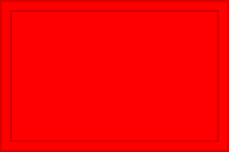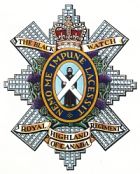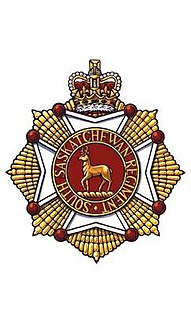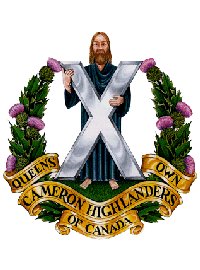
The 2nd Canadian Division, an infantry division of the Canadian Army, was mobilized for war service on 1 September 1939 at the outset of World War II. Adopting the designation of the 2nd Canadian Infantry Division, it was initially composed of volunteers within brigades established along regional lines, though a halt in recruitment in the early months of the war caused a delay in the formation of brigade and divisional headquarters. With questions concerning overseas deployment resolved, the division's respective commands were formed in May and June 1940, and at British Prime Minister Winston Churchill's request, the division was deployed to the United Kingdom between 1 August and 25 December 1940, forming part of the Canadian Corps.

The Calgary Highlanders is a Canadian Army Primary Reserve infantry regiment, headquartered at Mewata Armouries in Calgary, Alberta, Canada. The regiment is a part-time reserve unit, under the command of 41 Canadian Brigade Group, itself part of 3rd Canadian Division, one of four region-based Canadian Army divisions. The regiment is one of only two regiments in the Canadian Forces to wear an honorary distinction on their uniform, commemorating the counterattack at Kitcheners' Wood. On 9 January 2015, the regiment was recognized with the Canadian Forces' Unit Commendation for outstanding contributions to the war in Afghanistan.

The Royal Regiment of Canada is a Primary Reserve infantry regiment of the Canadian Army. The regiment is based in Toronto, Ontario, and forms part of the 4th Canadian Division's 32 Canadian Brigade Group.

The 1st Canadian Division is an operational command and control formation of the Canadian Joint Operations Command, based at CFB Kingston.

The 2nd Canadian Division is a formation of the Canadian Army in the province of Quebec, Canada. The present command was created 2013 when Land Force Quebec Area was re-designated. The main unit housed in this division is the Royal 22nd Regiment based at CFB Valcartier near Quebec City, which is the biggest regiment in the Canadian Army.

The 3rd Canadian Division is a formation of the Canadian Army responsible for the command and mobilization of all army units in the provinces of Manitoba, Saskatchewan, Alberta and British Columbia, as well as all units extending westwards from the city of Thunder Bay.

The 4th Canadian Division is a formation of the Canadian Army. The division was first created as a formation of the Canadian Corps during the First World War. During the Second World War the division was reactivated as the 4th Canadian Infantry Division in 1941 and then converted to armour and redesignated as the 4th Canadian (Armoured) Division. Beginning in 1916 the division adopted a distinctive green-coloured formation patch as its insignia. In 2013 it was announced that Land Force Central Area would be redesignated 4th Canadian Division. It is currently responsible for Canadian Army operations in the Canadian province of Ontario and is headquartered at Denison Armoury in Toronto.

The Argyll and Sutherland Highlanders was a line infantry regiment of the British Army that existed from 1881 until amalgamation into the Royal Regiment of Scotland on 28 March 2006.

The Royal Hamilton Light Infantry (RHLI) is a Primary Reserve infantry regiment of the Canadian Army, based at John Weir Foote VC Armoury in Hamilton, Ontario. The RHLI is part of 31 Canadian Brigade Group, which is part of 4th Canadian Division.

The Toronto Scottish Regiment is a Primary Reserve infantry regiment of the Canadian Army. It is part of 4th Canadian Division's 32 Canadian Brigade Group.

The Black Watch of Canada is a reserve infantry regiment in 34 Canadian Brigade Group, 2nd Canadian Division, of the Canadian Army. The regiment is located on Bleury Street in Montreal, Quebec, Canada, and is currently commanded by Lieutenant-Colonel J.B.F Roy, CD. The regiment's armoury was designated a National Historic Site of Canada in 2008. They are the senior Canadian-Scottish Regiment.

The 5th Canadian Infantry Brigade was an infantry brigade of the Canadian Army that fought during World War I and World War II. Raised in 1915, it formed part of the 2nd Canadian Division and fought on the Western Front during World War I before being disbanded. Later, it was re-raised in September 1939 and subsequently took part in Allied operations in north-west Europe in 1944 and 1945.

The South Saskatchewan Regiment was an infantry regiment of the Canadian Forces formed in 1936 by the amalgamation of The Weyburn Regiment and The Saskatchewan Border Regiment. It was reduced to nil strength and placed on the Supplementary Order of Battle in 1968. They participated in the 1942 Dieppe Raid, during which they undertook a supplementary, secret mission to guard, and if necessary, kill, a radar technician trying to discover vital information on the German radar station outside Dieppe.

The Seaforth Highlanders was a line infantry regiment of the British Army, mainly associated with large areas of the northern Highlands of Scotland. The regiment existed from 1881 to 1961, and saw service in World War I and World War II, along with many smaller conflicts. In 1961 the regiment was amalgamated with the Queen's Own Cameron Highlanders to form the Queen's Own Highlanders, which merged, in 1994, with the Gordon Highlanders to form the Highlanders. This later joined the Royal Scots Borderers, the Black Watch, the Royal Highland Fusiliers and the Argyll and Sutherland Highlanders to create the present Royal Regiment of Scotland.

The Queen's Own Cameron Highlanders of Canada is a Primary Reserve infantry regiment of the Canadian Army. It is part of the 3rd Canadian Division's 38 Canadian Brigade Group and is headquartered at the Minto Armoury in Winnipeg, Manitoba. It is the oldest highland regiment in Western Canada.

The 4th Canadian Infantry Brigade was an infantry brigade of the Canadian Army active during World War I and World War II. Raised in 1915, the brigade formed part of the 2nd Canadian Division and fought on the Western Front between 1916 and 1918. The brigade was re-raised in 1939 for service during World War II and subsequently took part in actions at Dieppe in 1942 and then in north-west Europe during 1944 and 1945.

The 7th Canadian Infantry Brigade was an infantry brigade of the Canadian Army that fought during World War I and World War II. The brigade, along with the 8th Canadian Infantry Brigade and the 9th Canadian Infantry Brigade, formed the 3rd Canadian Infantry Division. The division was formed in late 1915 in France, and served on the Western Front until the armistice in November 1918. Later, during World War II, it arrived in the United Kingdom in 1940 and spent three years in garrison duties and training in preparation for the assault landings on Juno Beach in Normandy on 6 June 1944. After fighting in Normandy, the brigade took part in the Battle of the Scheldt. After the war, it served on occupation duties until being disbanded in June 1946.
The 2nd Canadian Infantry Brigade was a formation of the Canadian Army that served in both World War I and World War II. The brigade fought on the Western Front during World War I, and in Sicily and Italy during the Second World War. In both wars, the brigade formed part of the 1st Canadian Division.

The 3rd Canadian Infantry Brigade was a formation of the Canadian Army in both World War I and World War II. The brigade fought on the Western Front during the First World War, and in Sicily and Italy during the Second World War.
The 13th Canadian Infantry Brigade was a formation of the Canadian Army that served in both World Wars. During World War I, the brigade formed part of the 5th Canadian Division. However, the 13th Brigade never saw combat as the brigade along with the 5th Canadian Division was broken up to provide reinforcements to the 4 other divisions of the Canadian Corps. During the Second World War, the brigade formed part of the 6th Canadian Infantry Division serving on the west coast in the home defence role and in June 1943, the brigade took part in Operation Cottage on Kiska during the Aleutian Islands campaign.

















